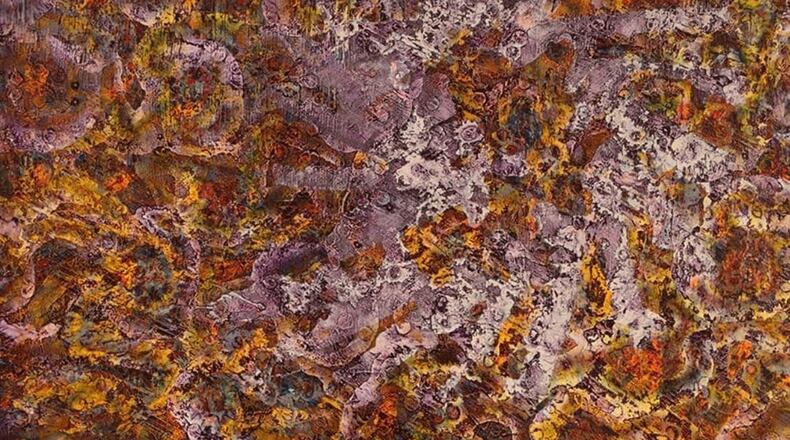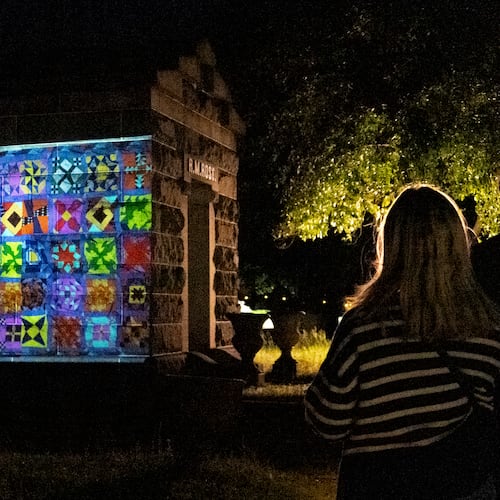This story was originally published by ArtsATL.
Herbert Creecy (1939-2003) remains a Georgia-based painter who has yet to be satisfactorily categorized because of the exuberant diversity of his aesthetic choices.
With “Herbert Creecy: Made in Space, Paintings from 1992-2001,” at Johnson Lowe Gallery through April 19, gallery director Donovan Johnson has curated a show that gives us yet another hitherto unnoticed aspect of Creecy’s sprawling oeuvre. Johnson also has made an impressive initial attempt at suggesting that Creecy was in creative conversation with a broad succession of trends in American painting during the half century of his career.
Those who are familiar only with the maximalist excess with which Creecy is most often associated may be astonished by the restraint of so many of these paintings. An artist associated with extraordinarily thick impasto effects is here distributing paint in minimal compositions by using an air compressor.
But this is only one of the surprises in this engaging exhibition. Some paintings’ rough, evocative surfaces almost suggest an otherworldly landscape; others consist of no more than a series of marks on an otherwise imageless field.
Credit: Photo by Jerry Siegel
Credit: Photo by Jerry Siegel
Johnson Lowe Gallery has created an online viewing room in which the paintings are subjected to substantial analysis, which frequently takes issue with common assumptions about Creecy. For example, the commentary claims that “Creecy never quite abandoned abstract expressionism, but, by this point, he had retooled it.”
Rather than being concerned entirely with “their own internal logic,” these paintings were addressing such topics as “the tension between modernist faith in materiality and postmodern skepticism toward gesture and authorship.”
Any assessment of the validity of these convincingly presented arguments will have to wait for an extended retrospective exhibition. What will count most for many viewers of “Made in Space” is the quite different visual impact of these paintings: This is a Herbert Creecy who evinces a degree of delicate subtlety at odds with the blunt assertiveness associated with so much of his work.
It may be true, as the viewing-room statement puts it quite poetically, that “the work hovers, just as it always has, between fact and fiction, between the terrestrial and the aerial, between gesture and the ghost of a gesture.” However, the Creecy who eludes the viewer’s comfortable comprehension in this exhibition is a different Creecy from the one to whom longtime viewers had grown accustomed.
No matter into what conceptual framework these paintings are eventually fitted, they serve as an intellectually stimulating and often sensorially seductive reminder that Creecy deserves a still more comprehensive assessment than the numerous and often career-spanning exhibitions of his work over the years have managed to give him.
The breadth of Creecy’s ambition and imagination has left an enigmatic legacy that only fresh scholarly assessment can hope to clarify.
::
Jerry Cullum’s reviews and essays have appeared in Art Papers magazine, Raw Vision, Art in America, ARTnews, International Review of African American Art and many other popular and scholarly journals. In 2020, he was awarded the Rabkin Prize for his outstanding contribution to arts journalism.
Credit: ArtsATL
Credit: ArtsATL
MEET OUR PARTNER
ArtsATL (artsatl.org) is a nonprofit organization that plays a critical role in educating and informing audiences about metro Atlanta’s arts and culture. ArtsATL, founded in 2009, helps build a sustainable arts community contributing to the economic and cultural health of the city.
If you have any questions about this partnership or others, please contact Senior Manager of Partnerships Nicole Williams at nicole.williams@ajc.com.
About the Author
Keep Reading
The Latest
Featured




